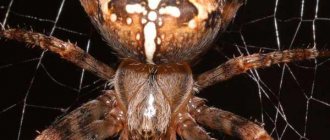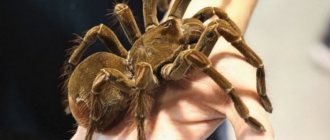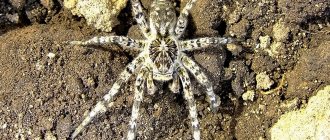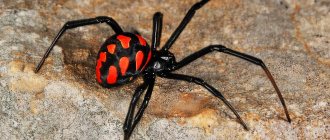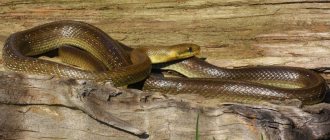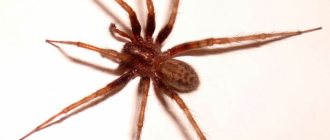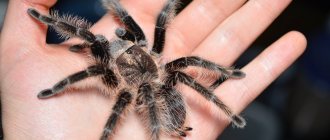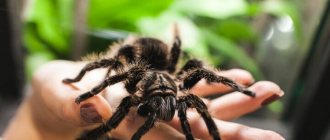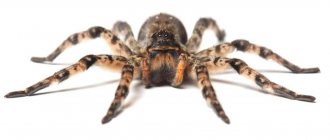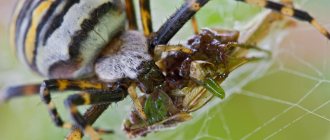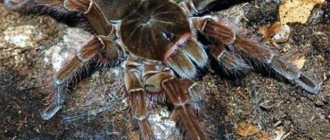Poisonous spiders are often found in residential buildings, causing a lot of inconvenience to owners. One of the most common varieties is the house recluse spider. Let us consider the features of the classification, behavior and structure of these arthropods, the prejudices and superstitions associated with them.
- Classification and habitat
- Features of behavior in the wild
- In a private house
- Black
- flies
- Takes away all the negative energy in the corners
Classification and habitat
There are three types of hermits:
- brown;
- black;
- brown.
The arthropod is distributed on three continents, including:
- Africa;
- North and South America.
Europe is home to a Mediterranean variety of spiders that are harmless to humans. The remaining species are found infrequently, entering with random parcels or on vehicles. The hermit spider in Russia is common in the middle and southern latitudes; to the north they live in human houses and utility rooms.
Reproduction
A female recluse spider mates with a male only once in its entire life. This is quite enough for periodic reproduction of offspring (150 eggs annually). Before mating, Chilean recluse spiders sometimes make an “offering” of an insect wrapped in a cocoon.
In May-June, the female lays eggs, weaving white cocoons (about 5 pieces in her entire life) with a diameter of 7.5 mm, then hides them in hard-to-reach places.
From each clutch, 40-50 cubs will appear in a month. They do not use the web for settlement; they remain to live at the place of their birth.
Features of behavior
The name "hermit" is explained by the solitary lifestyle. The animal is active at night, preferring solitary hunting. The hermit's web does not have an orderly pattern, it is extremely sticky to the touch, and is made of chaotically located white threads.
In wild nature
The hermit spider lives in warm climates, but is able to survive frosts down to 35 degrees, hiding under a stone or log. Arthropods live in forest areas and open spaces, preferring dry and secluded places.
In a private house
The domestic recluse spider can be found in secluded corners - in the attic, in the basement, under the bathroom, in crevices and inaccessible places. House spiders also live in utility rooms - garages, sheds, barns.
Arthropods often penetrate bedding, nest in closet compartments, inside beds and nightstands.
Latrodectus geometricus
Latrodectus geometricus, better known as the brown widow, is a species of spider found in many areas of South Africa, as well as in the United States, Australia, Afghanistan, China, Japan, Tanzania, Dominican Republic, Cyprus, Costa Rica, El Salvador, Brazil, United Arab Republics Emirates, Pakistan and Thailand. This species is often called the black widow's "cousin" (second on the list). The body length of females varies from 12 to 16 millimeters, males are much smaller - 6–8 mm, but they have longer legs. Typically, Latrodectus geometricus spiders are light brown in color and have a bright orange or yellow hourglass marking on the underside of their abdomen. Males are harmless, only females bite. The poison is relatively harmless to humans.
8
Body size and structure
The body size of an animal depends on its gender. An adult female grows up to twelve millimeters in length, a male – up to eight. Taking into account the leg span, the dimensions increase to twenty millimeters.
A characteristic feature of the species is a brown mark resembling a violin. It appears in mature individuals, but is sometimes noted in young spiders. The hermit has six eyes, unlike other species of arthropods, which have eight organs of vision.
At rest, the animal’s paws, devoid of spines, are thin and long, evenly spaced on the sides. When danger arises, the front legs are pulled under the body, the side legs are raised and the hind legs are straightened.
The paws and lower body are evenly colored, without spots or stripes. On the joint bends of the legs the shade of pigmentation is lighter compared to the main one. The color of the animal’s body is determined by its habitat and environmental conditions, varying from brown and dark brown to completely black.
The hermit's belly is covered with fine hair, resembling wool when examined under a microscope.
Description of the insect
Outwardly, the recluse spider reminds everyone of the familiar harmless haymaker. It has a small body 5-7 mm long and long legs with a span of up to 15-20 mm. It is colored brown, dark yellow or gray. On the cephalothorax there is a pattern similar to a violin.
The hermit has some features that distinguish it from other spiders:
- it has only three pairs of eyes, while other species have four;
- there is no pattern on the abdomen and legs;
- the body is covered with hairs;
- the web is sticky, chaotic, without the usual radial structure.
The arthropod received the name “hermit” due to its solitary lifestyle. It does not spread webs between trees or on grass. During the day, the spider hides in inaccessible dry places: under stones, snags, in crevices, in burrows of small animals, and only comes out to hunt at night.
This video explains the characteristics of the recluse spider:
It is not attached to its web and can move quite far from the nest. The brown recluse looks for other spiders and other insects, attacks them and injects poison, which instantly kills them. Spider venom is very toxic; its composition has not been fully studied.
Spiders make nests in hidden, hard-to-reach places. They spin cocoons and lay eggs in them. There are up to 40-50 eggs in one cocoon. The spider reliably guards the clutch and practically does not leave the nest until the offspring appear. As they grow, young spiders change their shell up to 8 times. The lifespan of hermits is 2−4 years, some individuals live up to 6 years.
https://youtube.com/watch?v=EHrWEmxEdxE
Varieties
There are three main species of Loxosceles reclusa, as this species of arthropod sounds in Latin.
Black
Presumably they originated from a cross between a black widow and a brown recluse spider. The most poisonous of all species. They live in the depths of dungeons and crevices. A popular character from a famous computer game, distinguished by a particular degree of danger for the player.
Brown
The most common variety. They originally lived in Latin America, from where they spread throughout the world since the 70s of the last century. They adapted to the conditions of existence next to humans.
Brown
Chilean subspecies. Less poisonous, common in Chile and Hawaii.
Mediterranean hermit spiders, distinguished by their red-brown or yellowish color, live in the southern latitudes of Europe and Russia. The degree of danger of the poison of this species of arthropod needs additional study.
Safe spiders
Representatives of this group either cannot bite through human skin, or their venom is too weak to cause harm. These spiders include:
- tarantulas;
- crosses;
- haymaker;
- brownie;
- horses.
Most spiders are not interested in humans. They live in nature and want only one thing: that no one touch them.
Tarantulas
The largest spiders. The champion of large arachnids in the world is the goliath spider: a tarantula whose body length reaches 10 cm. The goliath's paw span is 28 cm. The body is covered with red-brown thick bristles. The tarantula is not dangerous to humans, but falling bristles can cause an allergic reaction.
Crosses
Cross spiders are large spiders with a very large triangular-shaped abdomen. On the back there is a characteristic pattern in the form of a cross, which gave the name to the entire genus of cross spiders. Inhabitant of gardens, forests, parks and other green spaces. It hunts insects passively, weaving circular nets. The cross itself makes a shelter for itself out of rolled up leaves.
The bites are not dangerous. Even as a child it feels like a slight pinch. But a cross is able to discourage a child from grabbing a spider with his hands.
Types of safe spiders
Haymakers
Haymakers have no longer become house spiders, but “domesticated” ones and do not want to leave human habitation at all. They are completely safe for people and cannot even be pinched. Externally, harvest bugs are similar to the corn bug, but have an elongated body, divided into two parts. The bug has a round body.
Brownie
Belongs to the family of funnel-web spiders. Distributed everywhere. Often settles in human dwellings. The female house spider is 7-12 mm in size, the male is 6-9 mm. Color brown. Weaves funnel-shaped nets. It is not aggressive towards people, but if you stick your finger into its hiding place, it can bite. There will be no consequences from the bite.
Horses
Jumping spiders are one of the largest families. Distributed everywhere except Greenland. Spiders of this family are capable of jumping and actively hunt during the daytime. Horses have a well-developed hydraulic system, which allows them to change blood pressure and expand their limbs. Thanks to this device, they can make jumps many times greater than their own size.
Peacock spider
The original endemic of Australia from the racehorse family. A small spider with very bright colors. The peacock spider received its name for completely copying this bird: a bright male and a modest female. When courting a female, the spider “spreads its tail.” He straightens the side scutes of his abdomen and raises his hind legs with his abdomen up. In the absence of a female, spiders wrap scutes around their abdomen.
Types of safe spidersTramp
Hobo spiders get their name because they do not spin webs and hunt by ambushing their prey. The eye structure and hunting methods are similar to wolf spiders. The female uses the web to weave a cocoon in which she seals her eggs. The female carries the cocoon with her on her back.
Hunter bordered
Belongs to the family of sparassids - hunting spiders. The body can reach a length of 2 cm. Color variations range from yellow-brown to dark brown. There is a white stripe on the sides of the body. Distributed in temperate climates in Eurasia. Lives on the banks of water bodies. A distinctive feature of the hunter's spider is its ability to move through water and even dive if necessary. The second name for the hunter is fisherman, since the spider can catch and kill small fish. He doesn't care about people.
Green spider
It is impossible to determine the poisonousness of this arthropod, since the “green spider” species does not exist in nature. Different animals from different genera have this coloration:
- jumping spiders;
- hunting spiders;
- Lynx spiders.
All these green spiders are also found in Russia. To decide how dangerous a green spider bite is, you will first have to find out which family it belongs to.
Crab spider
It is also difficult to determine which particular crab spider we are talking about. Arthropods from three families have the ability to move sideways:
- Neocribellatae;
- Thomisidae (side-walking spiders);
- Philodromidae (isopods).
What does it eat?
A representative of the described species is capable of going without food and water for a long time. The spider's prey is insects, including their larvae. But hermits do not disdain their own relatives and small vertebrates. Unlike most other species, hermits do not resort to capturing victims using webs.
flies
Spiders lie in wait for their hunting targets, moving significantly away from the nest. Killing is carried out by injecting a toxin from special glands located on the cephalothorax.
The hunter does not resort to preserving the victim with a web, but immediately begins to process the prey, tearing the flesh with his jaws and injecting gastric juice.
Beetles
When hunting beetles, spiders expect the deadly effect of poison. After death, the victims begin to eat, turning the corpse into a comfortable position in the process of eating.
Insect larvae
The easiest prey for hermits due to their low mobility and lack of resistance.
Life cycle
Before being born from a mature egg, the embryos of the brown recluse spider are covered with a protective thin covering - the cuticle, and instead of jaws, two “egg teeth” erupt.
With their help, the juveniles break through the fetal membrane and emerge into a common cocoon - the nymph stage begins. When emerging, the individual is inactive, since the appendages have not yet been dismembered.
It feeds on the yolk formed in the intestines. The stage at which the nymph changes its shell and emerges from the cocoon is called preimaginal (imago - adult).
A young recluse spider changes its chitinous cover 5-8 times as it grows. Lives only 2-4 years (females longer). Individuals reach sexual maturity only a year after birth. Under favorable conditions, a brown spider can live up to 7 years.
Is it dangerous for humans?
Hermit spiders attack humans solely for the purpose of self-defense. Given the high degree of toxicity of the poison, these arthropods are extremely dangerous. In case of severe intoxication, the bite is fatal.
The wound from the bite of a brown recluse spider is small in size and therefore difficult to identify. The mark from an attack can easily be confused with a mosquito bite. Symptoms appear eight hours later as:
- a painful sensation in the area of the bite, gradually increasing and taking on a pulsating form;
- redness of the affected area; the bite site swells and becomes hot to the touch;
- as the poison spreads, the affected area expands, with an increase in the intensity of unpleasant sensations;
- elevated temperature; nausea, vomiting, dizziness, headache with possible loss of consciousness appear;
- the formation of a bursting blister at the site of the bite.
After twelve hours, the affected tissue begins to die. The consequences of a bite depend on the age and health of the victim.
If you are bitten by a recluse spider, you must:
- immediately wash the affected area with cold water and soap;
- treat the wound with an antiseptic;
- if a limb is affected, apply a tight bandage above the bite, trying to squeeze out some of the poison from the wound;
- Call an ambulance and apply cold to the affected area until the doctors arrive;
- Take broad-spectrum antibiotics and an antihistamine.
The likelihood of an attack is minimized after taking precautions:
- thorough inspection of personal clothing, shoes, bedding before use;
- When working in the garden and cleaning the premises, use gloves;
- free the house from unnecessary trash, rags, empty boxes;
- installing protective nets on windows, closing doorways in a similar way when the doors are open in the warm season;
- maintaining hygiene and cleanliness of the premises, eliminating the breeding of insects that attract spiders.
The listed actions are especially relevant when you are in a foreign country with unfamiliar fauna.
Karakurt
This spider is another representative of the black widow genus. Their distribution area is very vast; they can be found on all continents except Antarctica and the Arctic. Although the size of the karakurt is small - only 2-3 cm, it poses a mortal danger to humans. But only females are poisonous, and they attack only if they feel their life is threatened.
Bright red spots on the black body distinguish this spider from its relatives, but with age it can completely turn black. Karakurts settle mainly in dry places: on abandoned arable lands, near ravines. Sometimes they can visit people, crawling into houses, barns, garages and so on.
The bite of this species of black widows itself is not painful. But after a short time, when the poison begins to act, a person experiences severe poisoning. The place of the bite, and then the whole body, is pierced by a sharp pain, panic appears, it becomes difficult to breathe, and so on. A person is not in danger of instant death, but there is no need to delay in providing assistance.
Methods of control and prevention
To avoid the spread of “undesirable neighbors”, it is recommended to take the following measures:
- carry out wet cleaning of premises at least once a week;
- carry out cosmetic repairs every year - the smell of glue and building materials repels these animals;
- treat rooms with aromatic oils;
- seal cracks in building elements.
When cleaning, it is advisable to use a vacuum cleaner with a narrow nozzle that provides access to the most remote places.
The following means are used to control arthropods:
- Butox-50 is a Dutch drug. The concentrated oily emulsion is dissolved in water at the rate of thirty milliliters per bucket. Distributed by veterinary clinics and pharmacies. The product is toxic to people and pets, so the treated room needs subsequent ventilation.
- Diatomite is a rock. When exposed to an animal, it destroys the protective chitinous coating, leading to dehydration. Non-addictive, non-toxic.
- Horse chestnut - the fruit secretes a substance that is toxic to hermits.
- Walnut - any part of the tree is used, including fruit, peel, leaves. The tart smell of the nut repels spiders.
- Dried citrus peel has properties similar to nuts.
- Diluted vinegar causes damage to the skin when it gets on the animal’s body; an additional factor of influence is a sour smell.
The frequency of treatment and the choice of product depend on the characteristics of housing conditions and the degree of distribution of arthropods. When purchasing a chemical product, you must first study the instructions for use developed by the manufacturer.
What to do if you are bitten
First of all, you need to remain calm and call a doctor. It is advisable to catch the spider and place it in a durable container. This will help the specialist determine the type and degree of poisonousness of the spider. Then you need to try to prevent the poison from spreading throughout the body. Ice is applied to the bite site, and the bitten limb is raised higher. The wound needs to be treated with an antiseptic.
Further treatment depends on the severity of the bite. If no blister appears after eight hours of the bite, there is no severe pain and there are no signs of tissue necrosis, then serious treatment may not be required. If severe symptoms develop, corticosteroids are sometimes recommended. Dalsone, heparin, nitroglycerin and other drugs are also used. If severe necrosis develops, necrotic tissue must be removed surgically, and if a secondary infection develops, it must be treated. The ulcer usually heals on its own, but sometimes skin grafts are necessary. If systemic intoxication has developed, patients are hospitalized.
In the habitat of recluse spiders, in order to avoid being bitten, it is recommended to be careful with boxes, carefully inspect clothing and shoes, wear gloves when working with firewood, and also seal cracks through which spiders can crawl into the home
Signs and superstitions
Hermit spiders, like the rest of their relatives, are associated with many signs and superstitions.
Takes away all the negative energy in the corners
It is believed that the spider that lives in the house completely absorbs the negative energy accumulated in the corners. People have long believed that trouble and misfortune await a family that kills a spider.
To wealth and happiness
The house in which the spiders settled was considered rich and happy. The belief is based on a reasonable explanation: arthropods prefer to live in dry and warm rooms. A wealthy farmstead is characterized by the creation of suitable conditions for spiders to live.
If he hides, it will rain
They also try to link the behavior of arthropods to signs:
- if you are hiding, expect rain;
- In warm, dry weather, spiders actively build webs, catching your eye more often.
Often real predictions were based on these qualities of the animal.
Meet in the bathroom - loss of money or problems with your personal life
If an arthropod is found in an uncharacteristic habitat - the bathroom - this is associated with expected problems in your personal life or financial losses.
Bad or good news
Many people attach importance to the direction of movement of the animal in relation to the person. If the arthropod moves towards you, good news is expected, otherwise bad news.
Spiders in dreams
In dream books, the spider acts as a key figure determining the destiny:
- Gypsies believed that dreaming about a spider meant great luck;
- Miller's dream book - to career growth, a large cash bonus, positive assessment from management;
- according to Vanga - to scandals, serious disagreements;
- the Spaniards believe that arthropods dream of a loss of reputation associated with a scandalous story, a meeting with an ill-wisher;
- French belief - to treason.
Despite the various interpretations of beliefs and superstitions, the hermit spider is a dangerous animal for humans in direct contact. Therefore, reasonable preventive measures and knowledge of the animal’s behavioral characteristics will not hurt in order to protect yourself from undesirable consequences.
